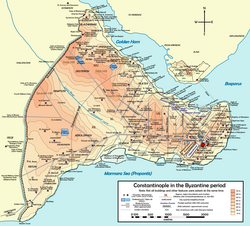Siege of Constantinople (1203)
| Siege of Constantinople | |||||||
|---|---|---|---|---|---|---|---|
| Part of the Fourth Crusade | |||||||
 Map of Constantinople during the Byzantine era |
|||||||
|
|||||||
| Belligerents | |||||||
| Byzantine Empire | Fourth Crusade | ||||||
| Commanders and leaders | |||||||
| Alexios III Angelos |
|
||||||
| Strength | |||||||
| 15,000 men and 20 ships | Crusaders: 10,000 men Venetians: 10,000 men and 210 ships |
||||||
The Siege of Constantinople in 1203 was a Crusader siege of the capital of the Byzantine Empire, in support of the deposed emperor Isaac II Angelos and his son Alexios IV Angelos. It marked the main outcome of the Fourth Crusade.
To take the city by force, the Crusaders first needed to cross the Bosphorus. About 200 ships, horse transports and galleys would undertake to deliver the crusading army across the narrow strait, where Alexius III had lined up the Byzantine army in battle formation along the shore, north of the suburb of Galata. The Crusaders' knights charged straight out of the horse transports, and the Byzantine army fled south. The Crusaders followed south, and attacked the Tower of Galata, which held one end of the chain that blocked access to the Golden Horn. As they laid siege to the Tower, the Greeks counterattacked with some initial success. However, when the Crusaders rallied and the Greeks retreated to the Tower, the Crusaders were able to follow the soldiers through the Gate, and the Tower surrendered. The Golden Horn now lay open to the Crusaders, and the Venetian fleet entered.
On 11 July the Crusaders took positions opposite the Blachernae palace on the northwest corner of the city. Alexios IV was paraded outside the walls, but the citizens were apathetic, as Alexios III, though a usurper and illegitimate in the eyes of the westerners, was an acceptable emperor for the Byzantine citizens. The siege began in earnest on 17 July, with four divisions attacking the land walls, while the Venetian fleet attacked the sea walls from the Golden Horn. The Venetians took a section of the wall of about 25 towers, while the Varangian guard held off the Crusaders on the land wall. The Varangians shifted to meet the new threat, and the Venetians retreated under the screen of fire. The fire lasted for 3 days and destroyed about 440 acres (1.8 km2) of the city, leaving 20,000 people homeless.
Alexius III finally took offensive action, and led 17 divisions from the St. Romanus Gate, vastly outnumbering the Crusaders. Alexius III's army of about 8,500 men faced the Crusader's 7 divisions (about 3,500 men), but his courage failed, and the Byzantine army returned to the city without a fight.
On 18 July 1203 the Crusaders launched an assault on the city, and Alexios III immediately fled into Thrace. The next morning, the Crusaders were surprised to find that the citizens had released Isaac II from prison and proclaimed him emperor, despite the fact that he had been blinded to make him ineligible to rule. The Crusaders forced Isaac II to proclaim his son Alexios IV co-emperor on 1 August, effectively ending the siege.
...
Wikipedia
